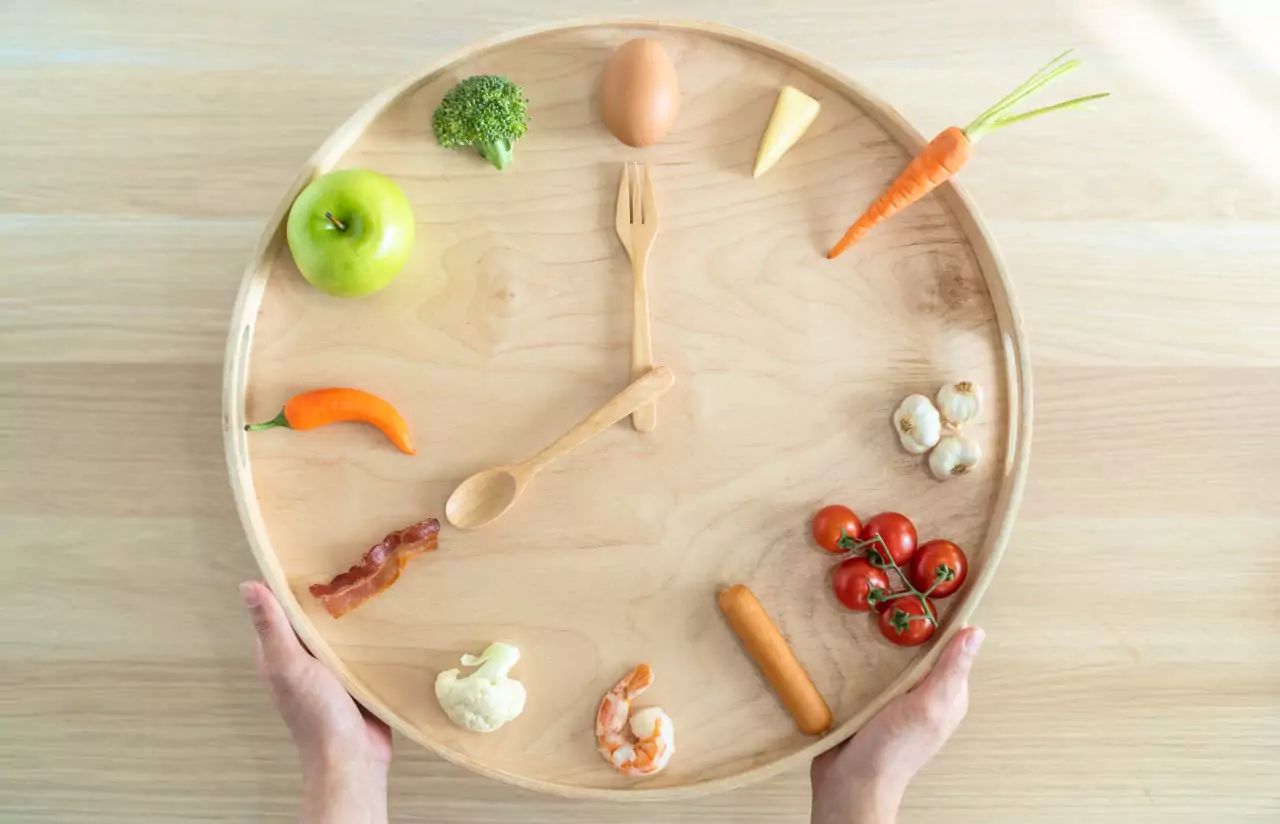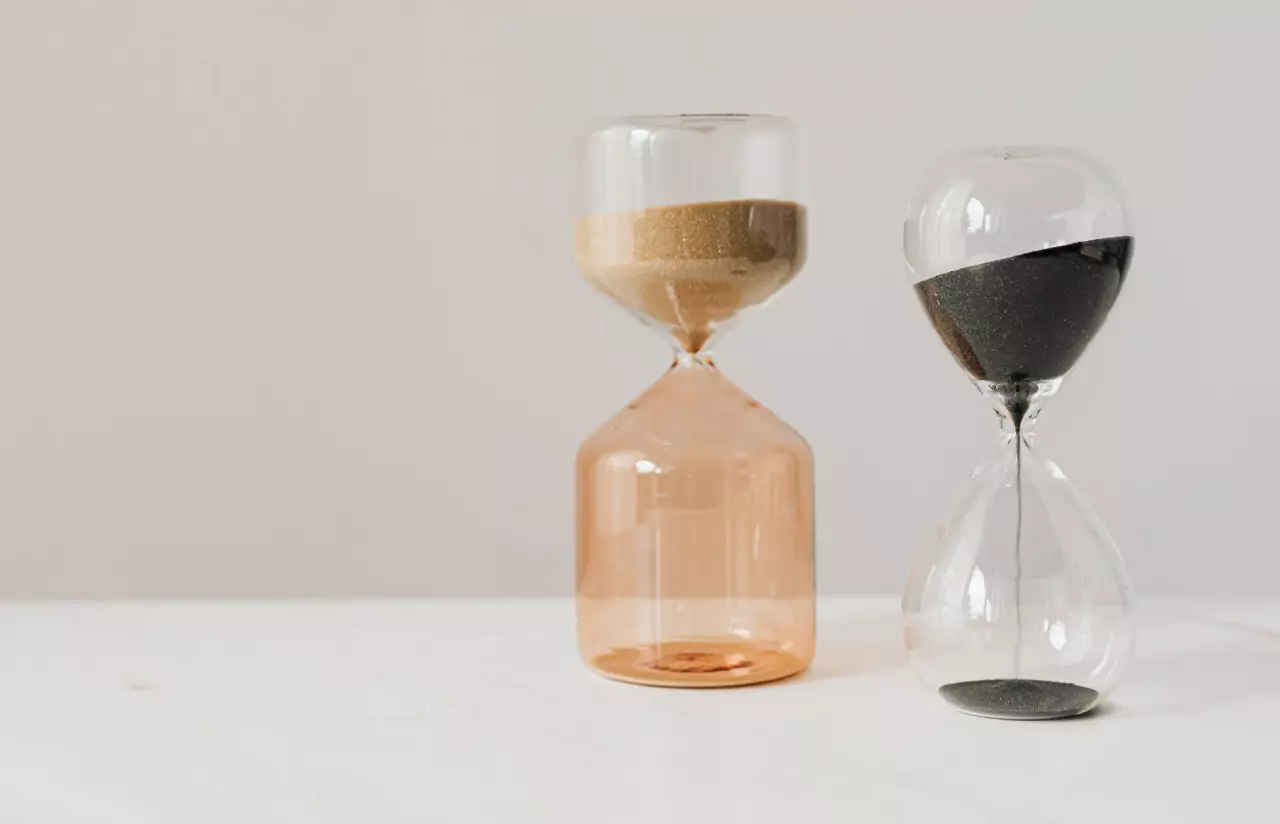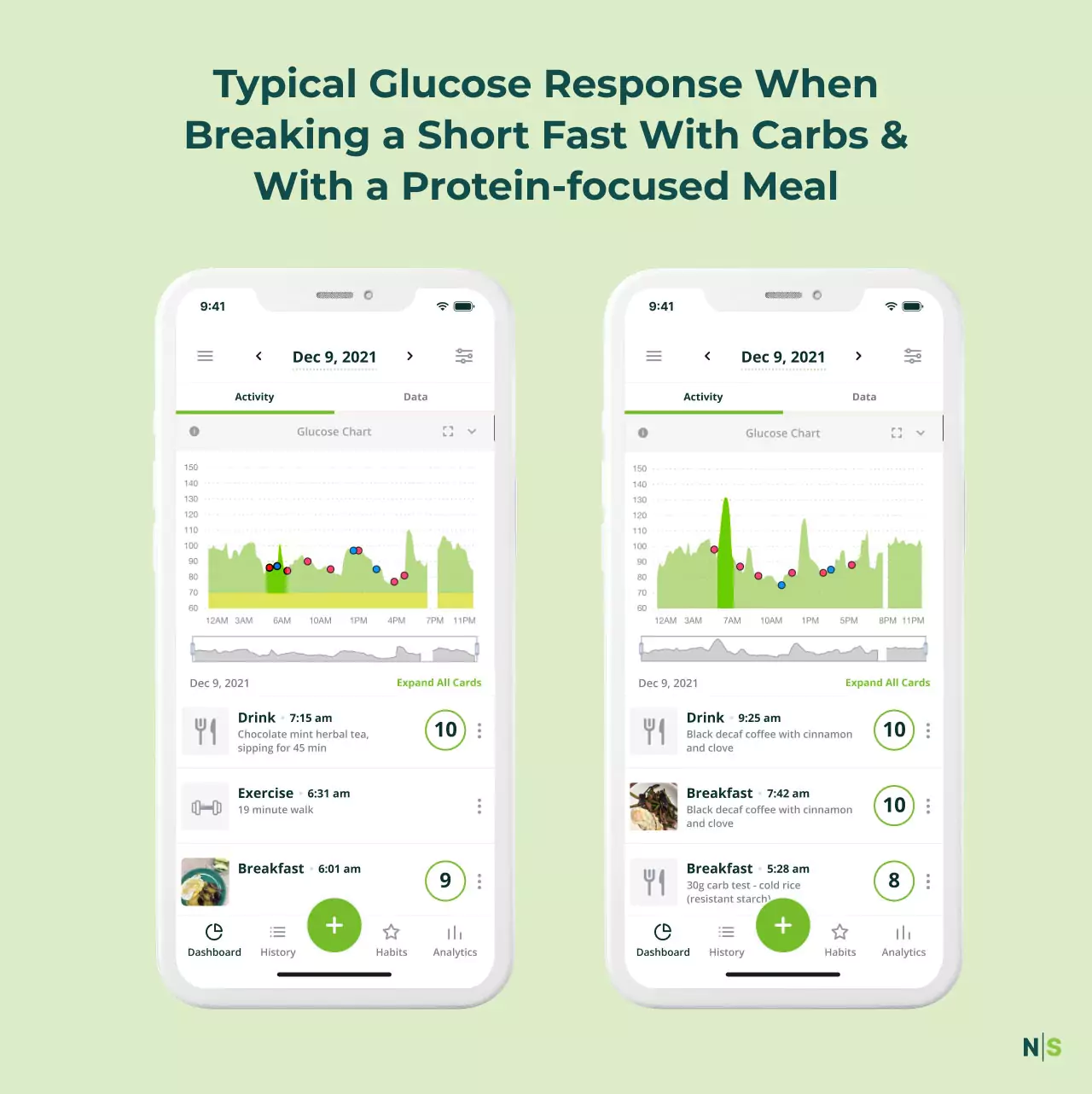How to Break Your Fast Without Messing up Your Glucose

Key Takeways
Intermittent fasting has gained popularity in recent years, and researchers continue to explore the potential benefits of this eating style. The research is truly promising: intermittent fasting has the potential to positively impact longevity, brain health, and metabolic well-being. Various intermittent fasting plans have demonstrated their efficacy as weight loss approaches and their ability to enhance several health indicators, including blood pressure and cholesterol levels. Additionally, they reduce the risk of chronic conditions including diabetes and heart disease.
Numerous studies indicate that fasting improves insulin sensitivity, cholesterol, triglyceride levels, and even mitochondrial efficiency. Moreover, it can also have a significant influence on blood glucose levels, which is highly relevant for people with diabetes and prediabetes. By helping them maintain their blood sugar within the target range, it empowers them to take charge of their health and well-being.
While the above sound promising, intermittent fasting may pose a few challenges.For example, leptin, the hormone that makes you feel full, decreases during fasting periods. This can lead to more hunger and cravings, making it difficult for some people to stick with intermittent fasting.
Additionally, it’s essential to break a fast with the right foods in order to balance blood sugar levels and meet overall nutrient needs. This may require careful planning and tracking of food and glucose to ensure that blood sugar is stable and the diet is well-rounded.
In this article, we'll discuss what to eat while following an intermittent fasting diet and how to break a longer period of fasting successfully.
What Can You Eat During a Fast?

First and foremost, it's important to have a clear understanding of what you can and can't consume during your fasting period. For instance, during some types of fasts you can enjoy black coffee, green or herbal tea, and broth. However, for stricter fasts, such as those focused on gut health, it's generally best to stick to water.
There's an ongoing debate about whether non-caloric sweeteners such as stevia, sucralose, and aspartame disrupt fasting. It's generally recommended to avoid them due to their potential to trigger the release of insulin.
Staying hydrated during a fast is also crucial, especially for longer fasting periods. Healthcare professionals recommended making an electrolyte drink with water, lemon juice, and a pinch of salt to replenish electrolytes that may be lost as ketone levels increase.
On the other hand, if you're doing a "fat fast", you're allowed to consume full-fat dairy, coconut oil, and MCT oil. This isn't technically a true fast, but it may help increase fasting time and boost ketone production. The key is to stick to high-fat, low-carb foods while you stay within your calorie restriction during this type of fast.
What to Eat When Breaking a Short Fast

While there is less to consider when breaking a fast of less than 24 hours, you should still pay attention to your first meal of the day to fully benefit from fasting.
How to Break Your Fast
A good rule of thumb is to prioritize protein, healthy fats, and low glycemic carbohydrates after an overnight fast. This trio will help stabilize your blood sugar and support your energy levels and appetite throughout the day.
Some sample meals for breaking a short fast:
- A piece of cheese 15 minutes before eating steel-cut oats with protein powder, nuts, and berries.
- One hard-boiled egg 15 minutes before eating a meal such as salmon, steamed vegetables, avocado, and feta.
- One or two pieces of sliced turkey 15 minutes before eating unsweetened Greek yogurt with berries, nuts, and chia seeds.
On the other hand, if you break an overnight fast with ultra-processed and refined carbs, you may feel tired and hungry soon after. That's because refined carbs are quickly digested by the body, which can lead to rapid changes in blood sugar.
It's a good idea to choose low glycemic carb sources in general, but especially after an overnight fast. Low glycemic carb sources include:
- Whole grains
- Fruits such as berries and apples
- Most vegetables
- Beans and legumes
Portion Size Matters

What about portion size? That matters, too. For example, one cup of oatmeal has more carbs than a half cup of oatmeal. As a result, you can expect that the larger portion size will likely impact your blood sugar to a larger a degree.
If you find yourself ravenous after fasting, start with a small serving of a balanced meal to gauge your satiety level. Only proceed to a second helping if you're still hungry. Your body takes time to detect fullness, and eating too quickly can cause you to overeat. Rapidly consuming excessive amounts can cause digestive discomfort and bloating.
Always listen to your body's hunger and fullness cues, as everyone's needs vary. Find a balance that works for you.
What to Eat When Breaking an Extended Fast

Extended fasting refers to fasting for 24 hours or more, and transitioning out of it is more challenging than breaking a shorter fast. Before we go into detail about what to eat when breaking an extended fast, let's discuss what happens when you come off a fast.
After 24 hours of fasting, most individuals experience a significant depletion of glycogen, which is the stored glucose reserves. Consequently, the body begins to employ stored fat, or ketones, as a source of energy. This process is known as lipolysis.
Between 24 and 72 hours of fasting, these ketone bodies become the primary fuel source for the body. To provide glucose to the brain and red blood cells, the body engages in gluconeogenesis, a process that creates new glucose from glycerol and amino acids. This process makes sure that essential organs have enough glucose to function properly.
Your Hunger Hormones
So, what happens to hunger? Under normal circumstances, your ghrelin and leptin hormones regulate your feelings of hunger and fullness. Ghrelin, known as the "hunger hormone," increases appetite, while leptin, known as the "satiety hormone," decreases appetite. They rise and fall in a cyclic pattern, keeping your hunger and fullness levels in balance.
However, during fasting, the levels of ghrelin, a hormone responsible for triggering hunger, decrease progressively every 24 hours. By the third day of fasting, the overall output of ghrelin is lower compared to the first and second days. These findings suggest why hunger levels tend to decrease around the third day of fasting.
What to Eat After Fasting

When ending an extended fast of 24 hours or more, it's advisable to concentrate on consuming small portions of easily digestible foods. After a prolonged period without food, your body requires time to adapt and resume the production of essential enzymes needed for digestion.
Instead of munching on fiber-rich foods and complex carbohydrates, which may lead to discomfort and bloating, consider starting with a nourishing bone broth soup and well-cooked vegetables as your first meal after a prolonged fast.
An alternative method involves slowly reintroducing food by savoring a warm broth for an hour before enjoying a light initial meal. You can enhance this first meal by adding a mixture of apple cider vinegar and lemon water, as it aids in supporting digestion during this transition period.
How Much Should You Eat?
How much you eat depends on your individual goals. After an extended fast, consider reintroducing foods in a low and slow manner. This means starting with small portions of easily digestible foods, like one cup of bone broth or cooked veggies.
Timing When Breaking a Fast

Does the timing of breaking your fast make a difference? Maybe. Some studies show that it's best to break a fast in the morning instead of at night. This has to do with our circadian rhythm and how the body digests food. Other research has demonstrated that consuming meals within a 10-hour time frame significantly enhances cardiometabolic health in people with metabolic syndrome.
Eating and sleeping outside of the circadian cycle increases the risk of developing a wide range of chronic diseases, including obesity, diabetes, and cardiovascular disease. However, if we break our fast while it is still daylight, we can offset this effect and greatly minimize the risks.
Differences in Gender
For women, there's an additional factor to consider. When women engage in a longer fast, their thyroid functioning tends to drop. This tends to be more pronounced in women who take thyroid medication, like levothyroxine.
When you break an extended fast, aim to eat thyroid-supportive foods containing zinc, iodine, and selenium. Adding foods like walnuts, almonds, seafood, seaweed, iodized salt, and Brazil nuts to your main meal may help support your thyroid.
Since women may respond differently to fasting than men, it's always an excellent idea to consult with a healthcare professional before starting any fasting routine. They'll help you determine if fasting is the right choice for you and provide guidance on how to safely break your fast.
Remember that each person's body is unique, and what works for one may not work for another. For some women, alternate-day fasting is a better option, while others may benefit from other forms of fasting, such as an eight hour eating window, other time-restricted eating schedules, or even just a caloric restriction diet.
What Not to Do When Breaking a Fast

You now know what to do when breaking a fast, but what should you avoid doing? It may seem pretty obvious, but try to avoid large portions or heavy meals right off the bat. It's also a good idea to steer clear of refined/starchy carbohydrates all on their own, and focus on lean protein, healthy fats, and low glycemic carbs instead.
After you break your fast, aim to go for a short, post-meal walk. This will help your body use the incoming glucose from food and produce a smoother glucose response. Additionally, aim to break your fast with a mindful meal without distraction. This can help you feel your hunger and fullness cues better and reduce the chance of overeating. Consider eating without distractions, taking at least 20 minutes for your meal, and practicing mindfulness while eating.
It's always a good idea to consult with an expert, such as your personal nutritionist at Nutrisense, to determine the best approach for your unique body.
People with diabetes, severe insulin resistance, liver or kidney disease should avoid fasting or consult with their healthcare provider before starting. Even if you are perfectly healthy, it's always a good idea to get a professional opinion to ensure your fasting plan aligns with your body weight loss goals.
A Typical Glucose Response
Curious to witness the impact of breaking a fast on your blood sugar levels? In the image below, observe the contrasting glucose responses when breaking a short fast with either carbohydrates or a protein-focused meal.
On the left, the highlighted green spike indicates the glucose surge following a protein-rich breakfast, breaking the fasting period. On the right, the highlighted spike represents the glucose response after breaking the fast with carbohydrates.
Both of these responses are 'good' responses, but the protein-focused meal produced a much smaller shift in glucose, which is tied to lower glycemic variability and more stable energy levels.

Engage with Your Blood Glucose Levels with Nutrisense
Fasting is a powerful tool for maintaining optimal health and regulating glucose levels. But it comes with a learning curve. With the Nutrisense CGM program, you can leave the guesswork behind by using a continuous glucose monitor (CGM) to provide real-time insights into your glucose levels.
By continuously tracking your blood sugar with a CGM or a glucose meter, you'll know how to keep your blood sugar level within a healthy range, how different foods and activities affect your glucose response as you break your fast, how to maintain steady energy levels throughout the day, and how to use all these data to reach your healthy weight goals.
If you have any questions or concerns, our team of credentialed dietitians and nutritionists are available for additional support and guidance to help you reach your goals. You're never alone on your health journey when you join the Nutrisense community.
Are you ready to embark on a transformative journey? Take the first step by diving into our quiz and unravel how Nutrisense can revolutionize your health.
Find the right Nutrisense programto turn insight into progress.
Go Beyond Glucose Data with Nutrisense
Your glucose can significantly impact how your body feels and functions. That’s why stable levels are an important factor in supporting overall wellbeing. But viewing glucose isn't enough. Nutrisense, you’ll be able to learn how to use your body's data to make informed lifestyle choices that support healthy living.
One-to-one coaching
Sign up to access insurance-covered video calls to work with a glucose expert: a personal registered dietitian or certified nutritionist who will help tailor your lifestyle and diet to your goals.
Monitor and measure what matters
With the Nutrisense CGM Program, you can monitor your glucose with health tech like glucose biosensors and continuous glucose monitor (CGM)s, and analyze the trends over time with the Nutrisense App. This will help you make the most informed choices about the foods you consume and their impact on your health.
Find your best fit
Ready to take the first step? Start with our quiz to find the right Nutrisense program to help you take control.

Carlee's training at Western Illinois University and an internship at the Memphis VA Hospital lead her to a career in outpatient counseling and bariatric nutrition therapy. In these positions, Carlee realized many of the disease states (upwards of 80%!) her patients experienced were actually preventable. She knew she had to dig deeper into preventative health and has since been passionate about helping people translate this complex glucose data into actionable changes anyone can implement into their everyday lives.

